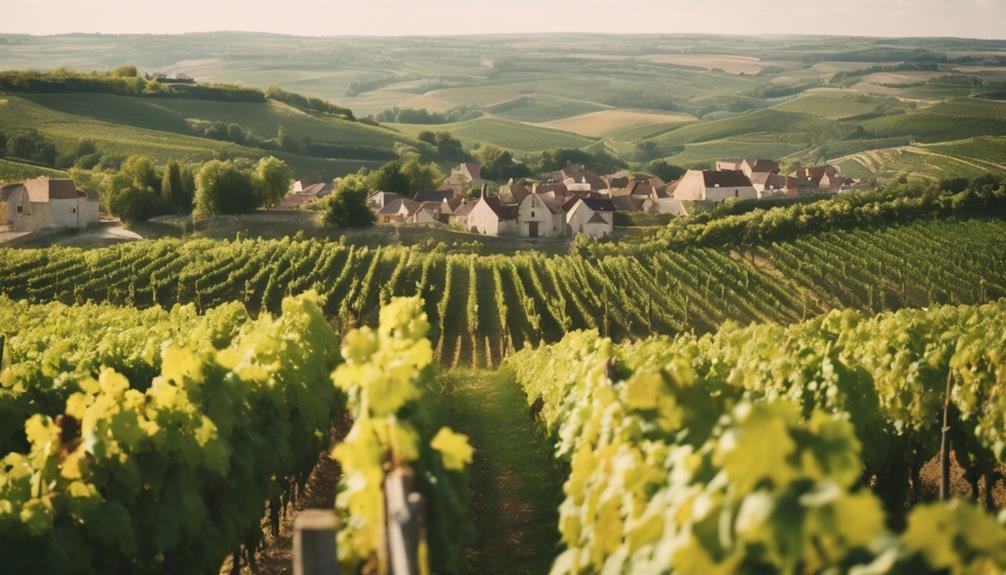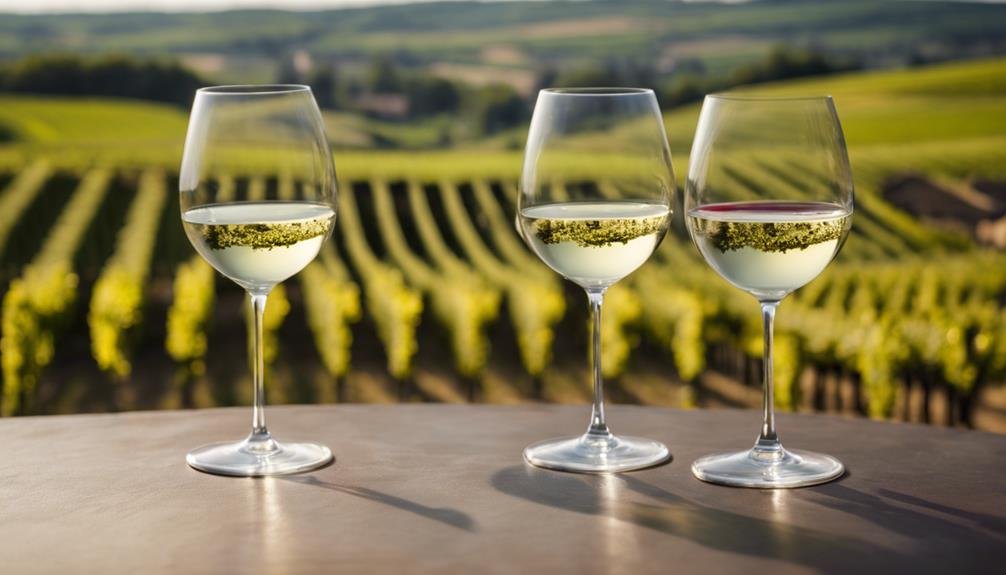Sancerre indisputably reigns as a top Sauvignon Blanc champion. The vineyards in the Loire Valley, spreading over 5,436 acres, produce renowned white wines with zesty citrus and herbal hints. The unique terroir, rolling hills, and diverse soils contribute to Sancerre's elegance. It stands out with its mineral notes, bracing acidity, and flinty-smoke flavors. Pairing well with seafood and grilled foods, Sancerre offers a distinctive taste preferred at summer BBQs. Prices range from $10 to $60 per bottle, with higher-end options providing more complexity. Choosing Sancerre around $25-$30 offers a quality Sauvignon Blanc experience. Learn more about Sancerre's flavor nuances and quality tiers.
Sancerre: Sauvignon Blancs French Heartland
Nestled in the heart of France's Loire Valley, Sancerre stands as the esteemed birthplace and unrivaled champion of flinty, savory Sauvignon Blanc wines.
The Sancerre vineyards, spanning over 5,436 acres for white wines, are renowned for producing some of the finest expressions of Sauvignon Blanc in the world. Situated in one of France's prestigious wine regions, Sancerre boasts a unique terroir that imparts distinct mineral notes and vibrant acidity to its wines.
The rolling hills and diverse soils of Sancerre contribute to the complexity and elegance of its Sauvignon Blanc, making it a favorite among wine enthusiasts and connoisseurs alike. The region's dedication to quality winemaking has solidified its reputation as a top destination for lovers of crisp, aromatic whites.
Sancerre Vs. Alternatives in Loire Valley
When comparing Sancerre to other alternatives in the Loire Valley, a discerning exploration of Sauvignon Blanc expressions reveals distinctive characteristics and value propositions.
Pouilly Fumé, known for its flinty and smoky notes, offers a compelling contrast to Sancerre's savory profile.
Menetou Salon provides a similar style to Sancerre at more accessible prices, showcasing acid-driven expressions of Sauvignon Blanc.
Reuilly and Quincy, also part of the Eastern Loire Valley, present options with their own unique takes on this grape variety. These alternatives share the region's focus on quality Sauvignon Blanc wines, each bringing its own terroir-driven nuances to the table.
Exploring these diverse options allows wine enthusiasts to appreciate the breadth of flavors available in the Loire Valley.
Sancerre: A Taste of Terroir

Sancerre's distinct flavor profile reflects the unique terroir of the region, showcasing the essence of its vineyards in every sip. Terroir influences, such as the soil composition, climate, and topography, impart specific characteristics to Sancerre wines.
The flavor nuances in Sancerre Sauvignon Blanc can range from zesty citrus notes like lime and gooseberry to herbal hints of chamomile and grass, with underlying tones of honeydew melon. The bracing acidity and flinty-smoke flavors are signatures of Sancerre, adding depth and complexity to the wines.
These elements, combined with the rich texture, create a distinctive taste that sets Sancerre apart as the spiritual home of Sauvignon Blanc, offering a true reflection of its terroir.
Sancerre: Perfect Pairings & Palate Pleasers
Exploring the culinary landscape, Sancerre's diverse flavor profile offers an array of perfect pairings and palate pleasers to elevate the dining experience.
Sancerre, known for its crisp acidity and vibrant fruit flavors, pairs exceptionally well with seafood dishes. The zesty citrus notes and mineral undertones of Sancerre complement the delicate flavors of fish and shellfish, creating a harmonious dining experience.
Additionally, Sancerre's invigorating qualities make it an ideal match for summer BBQs. Whether paired with grilled shrimp, seafood skewers, or barbecued chicken, Sancerre's lively acidity and herbal nuances cut through the smoky flavors, enhancing the overall enjoyment of the meal.
Embrace the versatility of Sancerre to elevate your seafood and summer BBQ gatherings.
Decoding Sancerre Prices & Quality Tiers

When it comes to Sauvignon Blanc wines, discerning buyers often find themselves exploring a spectrum of prices and quality tiers when contemplating Sancerre selections. Sancerre prices can range from $10 to $60 per bottle, with higher-end options offering more complexity of flavor. To guarantee better quality, anticipate spending around $25-$30 per bottle.
Areas such as Chavignol, Bué, and Ménétréol are known for producing excellent Sancerre wines that represent different quality tiers based on flavor complexity. When exploring value in Sancerre, it's crucial to take into account the tasting notes, which may include lime, gooseberry, pear, grass, chamomile, and honeydew melon flavors. These characteristics, in combination with the bracing acidity and rich texture, contribute to the overall quality of Sancerre wines.
Frequently Asked Questions
What Makes Sancerre Wines Different From New World Sauvignon Blancs?
Sancerre wines differ from New World Sauvignon Blancs due to their distinctive flavor profiles of lime, gooseberry, and bracing acidity. Vineyard practices in Sancerre emphasize terroir expression, with fermentation styles enhancing the wines' aging potential.
Are There Any Organic or Biodynamic Sancerre Producers to Look Out For?
Several Sancerre producers embrace organic or biodynamic practices, aligning with sustainability goals. Domaine Vacheron, Domaine Vincent Pinard, and Domaine Sébastien Riffault stand out for their commitment to eco-friendly viticulture, crafting exceptional wines with a focus on environmental responsibility.
Can Sancerre Wines Be Aged, and if So, How Do They Develop?
Sancerre wines can be aged to enhance complexity. Through the aging process, these wines develop richer flavors, including honeyed notes, heightened minerality, and a smoother texture. Properly cellared Sancerre can reveal nuanced characteristics over time.
Are There Any Unique Winemaking Techniques Used in Sancerre Production?
Barrel fermentation is not a typical practice in Sancerre production, as the focus is on preserving mineral-driven purity. Soil composition, climate impacts, and precise harvest timing define Sancerre's elegance and typicity in winemaking.
How Does the Geology of Sancerre's Terroir Influence the Wine's Taste?
The geology of Sancerre's terroir influences its wine's taste through the unique soil composition, which imparts minerality, and the climate influence, providing ideal conditions for Sauvignon Blanc. Vineyard management practices and the grape variety further enhance the distinct flavor profile.
Conclusion
In the world of Sauvignon Blanc, Sancerre shines as a top contender, but it is not the sole champion. Alternatives like Pouilly-Fumé, Menetou-Salon, Reuilly, and Quincy offer similar styles at more accessible prices.
Sancerre's distinct flavors of lime, gooseberry, and flinty-smoke make it a standout choice, but the Loire Valley has a variety of options to explore. Whether Sancerre truly reigns as the Sauvignon Blanc champion is ultimately a matter of personal preference and taste.
